Rowan
The rowans (/ˈraʊənz/ ROW-ənz or /ˈroʊənz/ ROH-ənz)[1] or mountain-ashes are shrubs or trees in the genus Sorbus of the rose family, Rosaceae. They are native throughout the cool temperate regions of the Northern Hemisphere, with the highest species diversity in the Himalaya, southern Tibet and parts of western China, where numerous apomictic microspecies occur.[2] The name rowan was originally applied to the species Sorbus aucuparia and is also used for other species in Sorbus subgenus Sorbus.[3]
| Rowan | |
|---|---|
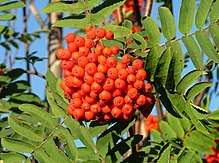 | |
| European rowan fruit | |
| Scientific classification | |
| Kingdom: | Plantae |
| Clade: | Tracheophytes |
| Clade: | Angiosperms |
| Clade: | Eudicots |
| Clade: | Rosids |
| Order: | Rosales |
| Family: | Rosaceae |
| Genus: | Sorbus |
| Subgenus: | Sorbus subg. Sorbus |
| Species | |
|
See text | |
Formerly, when a wider variety of fruits were commonly eaten in Europe and North America, Sorbus was a domestically used fruit throughout these regions. It is still used in some countries, but Sorbus domestica, for example, has largely vanished from Britain, where it was traditionally appreciated.[4] Natural hybrids, often including Sorbus aucuparia and the whitebeam, Sorbus aria, give rise to many endemic variants in the UK.[5]
Names
The traditional names of the rowan are those applied to the species Sorbus aucuparia, Sorbus torminalis (wild service-tree), and Sorbus domestica (true service-tree). The Latin name sorbus was borrowed into Old English as syrfe. The name "service-tree" for Sorbus domestica is derived from that name by folk etymology. The Latin name sorbus is from a root for "red, reddish-brown" (PIE *sor-/*ser-); English sorb is attested from the 1520s in the sense "fruit of the service tree", adopted via French sorbe from Latin sorbum "service-berry". Sorbus domestica is also known as "whitty pear", the adjective whitty meaning "pinnate". The name "mountain-ash" for Sorbus domestica is due to a superficial similarity of the rowan leaves to those of the ash, not to be confused with Fraxinus ornus, a true ash that is also known as "mountain ash".[6] Sorbus torminalis is also known as "chequer tree"; its fruits, formerly used to flavour beer, are called "chequers", perhaps from the spotted pattern of the fruit.
The name "rowan" is recorded from 1804, detached from an earlier rowan-tree, rountree, attested from the 1540s in northern dialects of English and Scots. It is from a North Germanic source, derived from Old Norse reynir (c.f. Norwegian rogn, Danish røn, Swedish rönn), ultimately from the Germanic verb *raud-inan "to redden", in reference to the berries (as is the Latin name sorbus). Various dialectal variants of rowan are found in English, including ran, roan, rodan, royan, royne, round, and rune.
The Old English name of the rowan is cwic-beám, which survives in the name quickbeam (also quicken, quicken-tree, and variants). This name by the 19th century was reinterpreted as connected to the word witch, from a dialectal variant wick for quick and names such as wicken-tree, wich-tree, wicky, and wiggan-tree, giving rise to names such as witch-hazel[7] and witch-tree.[8]
The Old Irish name is cairtheand, reflected in Modern Irish caorthann. The "arboreal" Bríatharogam in the Book of Ballymote associates the rowan with the letter luis, with the gloss "delightful to the eye (li sula) is luis, i.e. rowan (caertheand), owing to the beauty of its berries". Due to this, "delight of the eye" (vel sim.) has been reported as a "name of the rowan" by some commentators.
The more common Scots Gaelic name is caorunn (pronounced choroon, the ch as in loch), which crops up in numerous Highland place names such as Beinn Chaorunn in Inverness-shire and Loch a’chaorun in Easter Ross. Rowan was also the clan badge of the Malcolms and McLachlans. There were strong taboos in the Highlands against the use of any parts of the tree save the berries, except for ritual purposes. For example a Gaelic threshing tool made of rowan and called a buaitean was used on grain meant for rituals and celebrations.
In the Canadian provinces of Newfoundland and Labrador and Nova Scotia, this species is commonly referred to as a "dogberry" tree.[9] In German, Sorbus aucuparia is known as the Vogelbeerbaum ("bird-berry tree") or as Eberesche. The latter is a compound of the name of the ash tree (Esche) with what is contemporarily the name of the boar (Eber), but in fact the continuation of a Gaulish name, eburo- (also the name for a dark reddish-brown colour, cognate with Greek orphnos, Old Norse iarpr "brown"); like sorbus, eburo- seems to have referred to the colour of the berries; it is also recorded as a Gaulish name for the yew (which also has red berries), see also Eburodunum (disambiguation). The Welsh name criafol refers to the tree as "lamenting fruit", associating the red fruit with the blood of Christ, as Welsh tradition believed the Cross was carved from the wood of this tree.
Botany
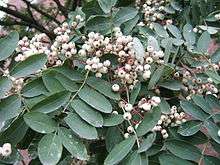
Rowans are mostly small deciduous trees 10–20 m tall, though a few are shrubs. Rowans are unrelated to the true ash trees of the genus Fraxinus, family Oleaceae. Though their leaves are superficially similar, those of Sorbus are alternate, while those of Fraxinus are opposite.[10]:388 Rowan leaves are arranged alternately, and are pinnate, with (7–)11–35 leaflets. A terminal leaflet is always present. The flowers are borne in dense corymbs; each flower is creamy white, and 5–10 mm across with five petals. The fruit is a small pome 4–8 mm diameter, bright orange or red in most species, but pink, yellow or white in some Asian species. The fruit are soft and juicy, which makes them a very good food for birds, particularly waxwings and thrushes, which then distribute the rowan seeds in their droppings.[2] Due to their small size the fruits are often referred to as berries, but a true berry is a simple fruit produced from a single ovary, whereas a pome is an accessory fruit.
Rowan is used as a food plant by the larvae of some Lepidoptera species; see Lepidoptera that feed on Sorbus.
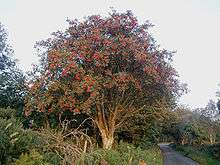
The best-known species is the European rowan Sorbus aucuparia, a small tree typically 4–12 m tall growing in a variety of habitats throughout northern Europe and in mountains in southern Europe and southwest Asia. Its berries are a favourite food for many birds and are a traditional wild-collected food in Britain and Scandinavia. It is one of the hardiest European trees, occurring to 71° north in Vardø in Arctic Norway, and has also become widely naturalised in northern North America.
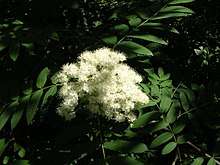
The greatest diversity of form as well as the largest number of rowan species is in Asia, with very distinctive species such as Sargent's rowan Sorbus sargentiana with large leaves 20–35 cm long and 15–20 cm broad and very large corymbs with 200–500 flowers, and at the other extreme, small-leaf rowan Sorbus microphylla with leaves 8–12 cm long and 2.5–3 cm broad. While most are trees, the dwarf rowan Sorbus reducta is a low shrub to 50 cm tall. Several of the Asian species are widely cultivated as ornamental trees.
North American native species in the subgenus Sorbus (Sorbus) include the American mountain-ash Sorbus americana and Showy mountain-ash Sorbus decora in the east and Sitka mountain-ash Sorbus sitchensis in the west.
Numerous hybrids, mostly behaving as true species reproducing by apomixis, occur between rowans and whitebeams; these are variably intermediate between their parents but generally more resemble whitebeams and are usually grouped with them (q.v.).
Selected species
- Sorbus amabilis
- Sorbus americana, American mountain-ash
- Sorbus aucuparia, European rowan
- Sorbus californica
- Sorbus cashmiriana, Kashmir rowan
- Sorbus commixta, Japanese rowan
- Sorbus decora, Showy mountain-ash
- Sorbus esserteauiana, Esserteau's rowan
- Sorbus fosteri
- Sorbus fruticosa
- Sorbus glabrescens, White-fruited rowan
- Sorbus groenlandica, Greenland mountain-ash
- Sorbus harrowiana, Harrow rowan
- Sorbus hupehensis, Hubei rowan
- Sorbus insignis
- Sorbus khumbuensis
- Sorbus koehneana
- Sorbus lanata
- Sorbus matsumurana
- Sorbus maderensis, Madeira rowan
- Sorbus microphylla, Small-leaf rowan
- Sorbus oligodonta, Kite-leaf rowan
- Sorbus pallescens
- Sorbus pekinensis
- Sorbus pinnatifida
- Sorbus pluripinnata
- Sorbus pohuashanensis
- Sorbus pontica
- Sorbus poteriifolia
- Sorbus prattii
- Sorbus pseudovilmorinii
- Sorbus pygmaea
- Sorbus randaiensis
- Sorbus redliana
- Sorbus reducta, Dwarf rowan
- Sorbus rehderiana
- Sorbus retroflexis
- Sorbus rockii
- Sorbus rotundifolia
- Sorbus rufo-ferruginea
- Sorbus rufopilosa, Tsema rowan
- Sorbus sargentiana, Sargent's rowan
- Sorbus scalaris, Ladder rowan
- Sorbus scopulina, Greene mountain-ash (var. scopulina) or Cascade mountain-ash (var. cascadensis)
- Sorbus simonkaiana
- Sorbus sitchensis, Sitka mountain-ash
- Sorbus splendens
- Sorbus stankovii
- Sorbus taurica
- Sorbus ursina
- Sorbus vertesensis
- Sorbus vestita
- Sorbus vilmorinii, Vilmorin's rowan
- Sorbus wardii
- Sorbus wilfordii
Uses
Rowans are excellent small ornamental trees for parks, gardens and wildlife areas. Several of the Asian species, such as White-fruited rowan (Sorbus glabrescens) are popular for their unusual fruit colour, and Sargent's rowan (Sorbus sargentiana) for its exceptionally large clusters of fruit. Numerous cultivars have also been selected for garden use, several of them, such as the yellow-fruited Sorbus 'Joseph Rock', of hybrid origin.[2] They are very attractive to fruit-eating birds, which is reflected in the old name "bird catcher".
The wood is dense and used for carving and turning and for tool handles and walking sticks.[11] Rowan fruit are a traditional source of tannins for mordanting vegetable dyes.[12] In Finland, it has been a traditional wood of choice for horse sled shafts and rake spikes.
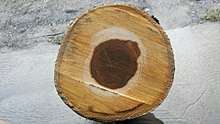
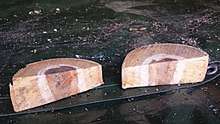
The fruit of European rowan (Sorbus aucuparia) can be made into a slightly bitter jelly which in Britain is traditionally eaten as an accompaniment to game, and into jams and other preserves either on their own or with other fruit. The fruit can also be a substitute for coffee beans, and has many uses in alcoholic beverages: to flavour liqueurs and cordials, to produce country wine, and to flavour ale. In Austria a clear rowan schnapps is distilled which is called by its German name Vogelbeerschnaps, Czechs also make a rowan liquor called jeřabinka,[13] the Polish Jarzębiak is Rowan-flavoured vodka, and the Welsh used to make a rowan wine called diodgriafel.[14]
Rowan cultivars with superior fruit for human food use are available but not common; mostly the fruits are gathered from wild trees growing on public lands.
Rowan fruit contains sorbic acid, and when raw also contains parasorbic acid (about 0.4%-0.7% in the European rowan[15]), which causes indigestion and can lead to kidney damage, but heat treatment (cooking, heat-drying etc.) and, to a lesser extent, freezing, renders it nontoxic by changing it to the benign sorbic acid. They are also usually too astringent to be palatable when raw. Collecting them after first frost (or putting in the freezer) cuts down on the bitter taste as well.
Mythology and folklore
Mythology
In Sami mythology, the goddess Ravdna is the consort of the thunder-god Horagalles. Red berries of rowan were holy to Ravdna, and the name Ravdna resembles North Germanic words for the tree (for example, Old Norse reynir).
In Norse mythology, the goddess Sif is the wife of the thunder god Thor, who has been linked with Ravdna. According to Skáldskaparmál the rowan is called "the salvation of Thor" because Thor once saved himself by clinging to it. It has been theorized that Sif was once conceived in the form of a rowan to which Thor clung.[16]
Folk magic
The European rowan (Sorbus aucuparia) has a long tradition in European mythology and folklore. It was thought to be a magical tree and give protection against malevolent beings.[17] The tree was also called "wayfarer's tree" or "traveler's tree" because it supposedly prevents those on a journey from getting lost.[18] It was said in England that this was the tree on which the Devil hanged his mother.[19]
British folklorists of the Victorian era reported the folk belief in apotropaic powers of the rowan-tree, in particular in the warding off of witches. Such a report is given by Edwin Lees (1856) for the Wyre Forest in the English West Midlands.[20] Sir James Frazer (1890) reported such a tradition in Scotland, where the tree was often planted near a gate or front door.[21]
According to Frazer, birds' droppings often contain rowan seeds, and if such droppings land in a fork or hole where old leaves have accumulated on a larger tree, such as an oak or a maple, they may result in a rowan growing as an epiphyte on the larger tree. Such a rowan is called a "flying rowan" and was thought of as especially potent against witches and black magic, and as a counter-charm against sorcery.[21] In 1891, Charles Godfrey Leland also reported traditions of rowan's apotropaic powers against witches in English folklore, citing the Denham Tracts (collected between 1846 and 1859).[lower-alpha 1] Rowan also serves as protection against fairies. For example, according to Thomas Keightley mortals could safely witness fairy rades (mounted processions held by the fairies each year at the onset of summer) by placing a rowan branch over their doors.[23]
Pagan revivalism
In Neo-Druidism, the rowan is known as the "portal tree". It is considered the threshold, between this world and otherworld, or between here and wherever you may be going, for example, it was placed at the gate to a property, signifying the crossing of the threshold between the path or street and the property of someone. According to Elen Sentier, "Threshold is a place of both ingress (the way in) and egress (the way out). Rowan is a portal, threshold tree offering you the chance of 'going somewhere ... and leaving somewhere."[24]
Weather-lore
In Newfoundland, popular folklore maintains that a heavy crop of fruit means a hard or difficult winter. Similarly, in Finland and Sweden, the number of fruit on the trees was used as a predictor of the snow cover during winter, but here the belief was that the rowan "will not bear a heavy load of fruit and a heavy load of snow in the same year", that is, a heavy fruit crop predicted a winter with little snow.
However, as fruit production for a given summer is related to weather conditions the previous summer, with warm, dry summers increasing the amount of stored sugars available for subsequent flower and fruit production, it has no predictive relationship to the weather of the next winter.[25][26]
In Malax, Finland the reverse was thought.[27] If the rowan flowers were plentiful then the rye harvest would also be plentiful. Similarly, if the rowan flowered twice in a year there would be many potatoes and many weddings that autumn. And in Sipoo people are noted as having said that winter had begun when the waxwings (Bombycilla garrulus) had eaten the last of the rowan fruit.[28]
In Sweden, it was also thought that if the rowan trees grew pale and lost color, the fall and winter would bring much illness.[29]
Popular culture
References to the rowan fruit's red color and the flowers' beauty are common in Celtic music. For example, the song Marie's Wedding contains the verse
- Red her cheeks as rowans are,
- bright her eyes as any star,
- fairest of them all by far,
- is our darling Marie.
J. R. R. Tolkien's novel The Two Towers employs rowans as the signature tree for the Ent, Quickbeam. The forest of Fangorn, where Quickbeam and other Ents live, is populated with numerous rowans that were said to have been planted by male Ents to please the female Entwives. Quickbeam declares his fondness for the tree by saying that no other "people of the Rose ... are so beautiful to me," a reference to the rowan's membership in the family Rosaceae.[30]
See also
- Rowntree, an English surname derived from "rowan tree"
- Sorbus subgenus Aria
- Sorbus subgenus Micromeles
- Sorbus subgenus Cormus
- Sorbus subgenus Torminaria
- Sorbus subgenus Chamaemespilus
Footnotes
- The anti-witch rhyme used in Tweedesdale some sixty or seventy years ago (viz. in the 1820s) was: "Black-luggie, lammer bead, rowan-tree and reed thread, put the witches to their speed. ... I have seen a twig of rowan-tree ... which had been gathered on the second of May" (observe this), wound round with some dozens of yards of red thread, placed visible in the window to act as a charm in keeping witches and Boggle boes from the house. — C.G. Leland[22]
References
- https://www.oxfordlearnersdictionaries.com/definition/english/rowan
- Rushforth, K. (1999). Trees of Britain and Europe. Collins ISBN 0-00-220013-9.
- McAllister, H.A. 2005. The genus Sorbus: Mountain Ash and other Rowans . Kew Publishing.
- "The Whitty Pear, Sorbus domestica"
- "Cambridge Botanic Garden: the Genus Sorbus". Botanic.cam.ac.uk. Retrieved 2018-07-12.
- "The similarities in the physical characteristics of all three types of tree [viz., Fraxinus excelsior, Fraxinus ornus, and Sorbus aucuparia] are pervasive enough that they are confused not only in folk terminology, but also in botanical nomenclature". Richard Stoll Shannon (1975). The Arms of Achilles and Homeric Compositional Technique Volume 36 of Mnemosyne, (Brill), p. 41. The English herbalist John Gerard in 1590 apparently fell victim to just this confusion, equating ornus and quickbeam (see below).
- "Witch-hazel" is much more commonly associated with Hamamelis.
- Abram Smythe Palmer, Folk-etymology: a Dictionary of Verbal Corruptions Or Words Perverted in Form Or Meaning, by False Derivation Or Mistaken Analogy (1882), 443f.
- Story, G. M. and Kirwin, W. J. (1990). Dictionary of Newfoundland English. University of Toronto Press. ISBN 0-8020-6819-7.
- Blamey, M.; Fitter, R.; Fitter, A (2003). Wild flowers of Britain and Ireland: The Complete Guide to the British and Irish Flora. London: A & C Black. ISBN 978-1408179505.
- Vedel, H., & Lange, J. (1960). Trees and Bushes in Wood and Hedgerow. Metheun & Co. Ltd., London.
- Henderson, Robert K. (2000). The Neighbourhood Forager: A Guide For The Wild Food Gourmet. Toronto: Key Porter Books. p. 68. ISBN 1-55263-306-3.
- "Sorbier des oiseleurs". Floratrek.hautetfort.com. 2011-06-25. Retrieved 2018-07-12.
- "Wild Food School". Countrylovers.co.uk. Retrieved 2018-07-12.
- O Raspe, C Findlay, AL Jacquemart. Sorbus aucuparia L. The Journal of Ecology, 2000
- Turville-Petre, E.O.G. (1964). Myth and Religion of the North: The religion of ancient Scandinavia. Weidenfeld and Nicolson. p. 98.
- "Mythology and Folklore of the Rowan". Trees for Life.
- Eyers, Jonathan (2011). Don't Shoot the Albatross! Nautical myths and superstitions. London, UK: A. & C. Black. ISBN 978-1-4081-3131-2.
- Westwood, Jennifer (1985). Albion: A guide to legendary Britain. London: Grafton Books. p. 257. ISBN 0-246-11789-3.
- Edwin Lees (1856). Pictures of nature in the Silurian region around the Malvern Hills and vale of Severn. H. W. Lamb. pp. 274ff – via Internet Archive.
- Frazer, James (1987). The Golden Bough (Papermac ed.). p. 620. ISBN 0-333-43430-7.
- Leland, Charles Godfrey (1891). Gypsy Sorcery and Fortune Telling. p. 198 – via Google Books.
- Keightley, Thomas (1884) [1828]. The Fairy Mythology. London: George Bell & Sons. pp. 354–355.
- Sentier, Elen (2014). Trees of the Goddess. Shaman Pathways. Alresford, Hants, SO24 9JH, UK: Moon Books. ISBN 978-1-78279-332-8.CS1 maint: location (link)
- Kobro, S.; Søreide, L.; Djønne, E.; Rafoss, T.; Jaastad, G.; Witzgall, P. (2003). "Masting of rowan Sorbus aucuparia L.". Population Ecology. 45 (1): 25–30.
- Raspe, O.; Findlay, C.; Jacquemart, A. (2000). "Sorbus aucuparia". Journal of Ecology. 88 (5): 910–930.
- Tillhagen, Carl-Herman. (1995). Skogarna och träden: Naturvård i gångna tider. Carlssons bokförlag, Stockholm.
- Mannhardt, Wilhelm (1963). "Der Baumkultus der Germanen und ihrer Nachbarstämmes". Wald- und Feldkulte (in German). Wissenschaftliche Buchgesellschaft Verlag. I: 52.
- Tillhagen, Carl-Herman (1995). Skogarna och träden: Naturvård i gånga tider (in Swedish). Stockholm: Carlssons bokförlag.
- Tolkien, J.R.R. (1982). The Two Towers. Book 3, ch 4: Del Rey Books. p. 102. ISBN 0345339711.CS1 maint: location (link)
External links
| Look up service tree, sorbus, mountain ash, or rowan in Wiktionary, the free dictionary. |
| Wikimedia Commons has media related to Sorbus. |